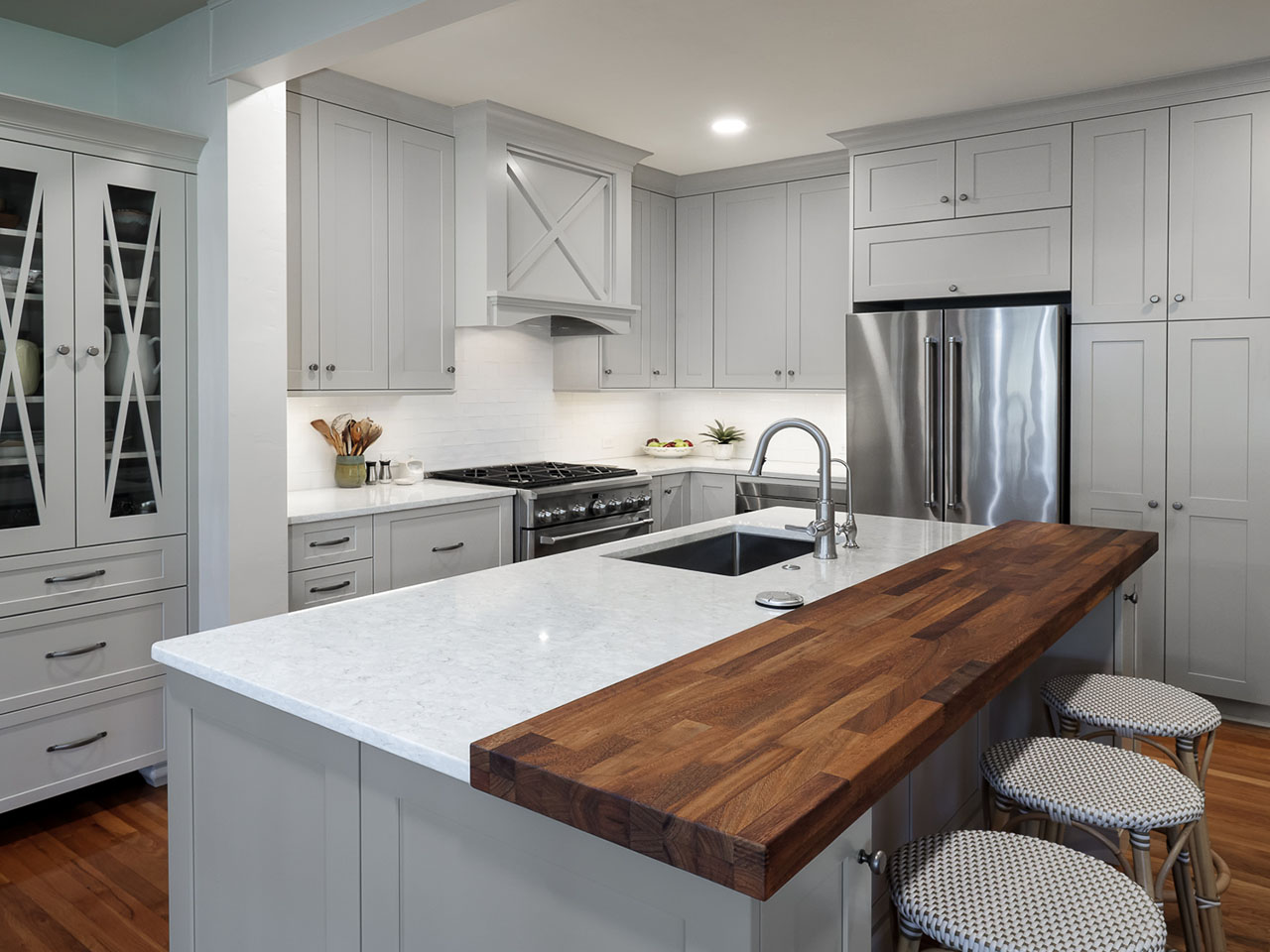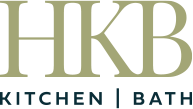Everything You Need to Know About Flooring for Kitchen & Bath Design
July 20, 2021

Choosing flooring for your Gainesville, FL home can be difficult. If you go on looks alone, you’re going to have problems as your chosen material might not work with your lifestyle or environment. There is always a practical solution to fit your style and requirements, but you must carefully consider what you need based on your home, family, and lifestyle.

-
Real hardwood might not work in your pet-friendly kitchen design, but a ceramic imitation or wood-look porcelain plank tile would be scratch-proof and still look fantastic.
-
A waterproof floor in your bathroom design could become slippery when wet, so look at non-slip options. This is particularly important if you have children or anyone with mobility limitations living in your home.
-
Maybe you have preconceptions about certain types of flooring that have actually had technological advancements in recent years and are now ideal for your kitchen or bathroom remodel.
-
Durability, moisture levels, and cost can all affect your choice and that’s before you think about color, texture, or style.

There are so many decisions to make during a kitchen or bathroom remodeling project. At Haile Kitchen & Bath, we offer a wide range of flooring options and can help find the perfect one for your home living spaces. In our latest blog, we will take you through the most popular types of flooring and tell you everything you need to know to help you get started in selecting the flooring to fit your home.
Solid Hardwood
Hardwood is a classic choice that always brings character to a room. There are two types of wood flooring available – solid and engineered hardwood. There are several practical and style factors to consider when deciding if hardwood is the right choice for you.

As a surface for busy kitchen and bathroom designs, solid hardwood is durable and warm but not completely waterproof and can be more susceptible to the effects of moisture in these spaces. It can also be a little slippery unless the surface is distressed or hand-scraped. While it brings its natural warmth, it does not pair as well with underfloor heating as some other materials.
Installation of hardwood flooring must be done carefully by an experienced professional. As a natural product, solid hardwood planks have to sit in their intended room to acclimatize and prevent shrinkage or swelling after they have been laid. They also need to be nailed or glued to a subfloor like plywood or concrete, so make sure to factor these costs into your budget.
Hardwood flooring has the long-term benefit that it can be refinished over the years to extend its life and get a different style with a new finish. This year sees an increase in mixing dark and light planks for an eclectic, eye-catching look. Overall, lighter colors such as blonde, honey, grays, and whitewashes, in reclaimed and sustainable woods, are trending this year, with oak, maple, and bamboo ideal choices. In the same way that tiles are larger and being laid in unusual patterns, planks are now longer and wider and also laid in unique patterns. Herringbone is ever popular, but now we are seeing a mix of plank widths as well as colors thrown into the mix. Hickory is a varied wood so ideal if you want complexity without mixing woods.

Engineered Hardwood
Engineered hardwood is lower maintenance for kitchen or bathroom design as the top layer is solid wood with dense plywood or fiberboard underneath. As with solid hardwood, it can be glued or nailed down but another option is to get planks that click together and float on the subfloor. As its surface is solid hardwood, it still scratches and marks like natural hardwood.
It isn’t waterproof either but is resistant to warping, so a great choice for moisture-prone areas, if you’re installing underfloor heating, or plan to install wide planks that need to stay level. Engineered hardwood is less costly and, depending on its thickness, it can be refinished over the years, but won’t last as long as solid wood. If eco-friendliness is important to you though, this is a good choice as it consists mostly of wood by-products, but you get the same look as its solid counterpart.
Laminate
Laminate is a more budget-friendly version of hardwood, having a core, like engineered hardwood, topped by an image of wood or stone that is then covered by a protective layer. It’s easy to install as it usually floats over a soft underlay.
This surface is perfect for high-traffic areas, as it is durable, warm, and won’t fade, scratch, or warp. Traditionally, it’s not waterproof, but exciting technological advancements mean many manufacturers now offer waterproof laminate flooring. This makes it an ideal option for moisture-prone kitchen and bathroom designs.
To avoid a slippery surface, go for a distressed or hand-scraped finish for traction. As with hardwood, the current trend is for lighter finishes with longer and wider planks.
Vinyl
Vinyl is another durable synthetic product that can mimic many other floor coverings. It is available as a single sheet that can be cut to size. It also comes in popular planks and tiles and more advanced products are referred to as luxury vinyl plank (LVP) or tile (LVT).

As with laminate, this is an imitation product made from vinyl, covered with a wear layer, and backed with a vinyl core. This core can be soft, but rigid core LVP (called EVP flooring) is stronger. Wood-polymer cores are good for comfort and stone-polymer cores are the most durable type. Vinyl can be glued but can also click together to float or be laid loose on top of other surfaces, but make sure that the surface underneath is completely smooth, or it will show through. Aside from durability, comfort, and cost, vinyl is completely waterproof so is an excellent, practical option for areas prone to spills or steam. You will need to invest in high-quality vinyl to get one with low VOCs. Linoleum is a similar option that includes natural products so might be one to consider if you want an eco-friendlier alternative.
Tile
Tile flooring is the perennial favorite for kitchen and bathroom floors. In addition to choosing a durable material, the tiles need to be laid, grouted, and sealed properly, and then regularly maintained to ensure they will last for years. There are many types of tiles, but the most popular are ceramic, stone, cement, and porcelain.

Ceramic tiles are made of baked clay and come in a large variety of shapes and styles. They have a natural feel and can either mimic wood and stone or be as patterned or colorful as you like. They are durable and waterproof, but grout should be cleaned frequently to enhance the tiles’ appearance.
Natural stone tiles include a huge range of popular choices in kitchen and bath design. Marble, granite, and sandstone are often used, with a focus on their organic beauty. They are high maintenance as they need to be regularly sealed but also are durable and timeless.
Cement tiles are becoming more popular in the US. Their intense patterns can be mixed and matched, bringing personality to any remodel. They need to be sealed properly but can also be refinished without damaging the surface.
Porcelain is a more refined and baked type of ceramic tile. It is exceptionally durable and stain-repellent. Being waterproof is a huge advantage for kitchen and bathroom design but this surface can be slippery, so opt for a slip-resistant surface with texture. Non-glazed porcelain and ceramic tiles are more prone to absorbing water and stains, but their roughness means chips and cracks are not as apparent and they’re slightly safer to walk on.

As with wood, mixing up tile sizes and patterns is very popular this year. Larger formats are on the rise along with square shapes and laying tiles in unusual ways to bring character to a floor.

Concrete
Stained concrete is a simple and hard-wearing option that works in any kitchen or bath design. Once it is sealed properly, concrete is completely waterproof, but this raises the ever-present issue of slipperiness in these busy, moisture-prone home living spaces. A matte surface paired with absorbent rugs in the bathroom or near the kitchen sink should solve this problem.
Most homes have concrete subfloors, so it’s just a matter of preparing the surface before you stain them. It’s possible to make concrete look like wood, tile, or stone, complete with grains or veining. Like other flooring materials, this year’s trend is veering towards lighter shades. Enhance your design with pattern and texture also, to enliven your budget-friendly concrete floor.
Terrazzo
Terrazzo has been around since the 15th century and is back with a bang. Chips of marble, glass, granite, and other aggregates are embedded into tinted cement or epoxy resin which is then ground smooth and polished. With a wide selection of chips and pigments, there are endless design options.
Terrazzo can be poured on-site or laid as pre-formed tiles. Easy to clean and hard to scratch, stain, or ignite, terrazzo also boasts low VOC levels and is very durable. It is also not as slippery as other hard flooring and can last a lifetime. The cons are that terrazzo tends to be cold without underfloor heating.
While it’s a trendy option, you need to consider the aggregates used or you could end up with a dated look for your kitchen or bath remodel. Also, the cost could be driven up by certain aggregates, such as marble.
Before you choose flooring, think about how it needs to perform, in addition to what your budget and style are. Will it be in an environment prone to moisture? If so, concrete, terrazzo, ceramic, porcelain, or vinyl tile would work. If you have pets walking around your kitchen, then a scratch-proof option is best. Solid hardwood is a classic choice but can scratch so be sure you are prepared to have it sanded to extend its lifespan.
If budget is an issue, then wood-effect laminate or resilient flooring, such as vinyl or laminate are your best options. There are cheap tiles available but are often a false economy, as they are labor-intensive to lay and prone to chipping, staining, and cracking. Vinyl, cement, and terrazzo are low maintenance, but nothing compares to solid hardwood or natural stone if you want real luxury. You can always cover busy areas with rugs or runners and regularly maintain your high-end flooring to enhance the style of your kitchen or bathroom design.
Haile Kitchen & Bath Has Your Dream Flooring
Visit us in our showroom or check out our online bathroom and kitchen design galleries to get inspired. Contact us today at Haile Kitchen & Bath to discuss flooring options for your kitchen or bathroom remodel.
